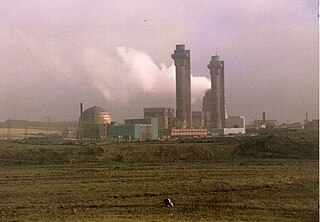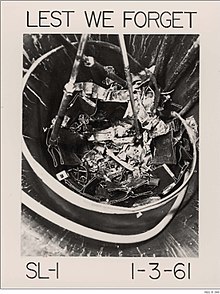A dirty bomb or radiological dispersal device is a radiological weapon that combines radioactive material with conventional explosives. The purpose of the weapon is to contaminate the area around the dispersal agent/conventional explosion with radioactive material, serving primarily as an area denial device against civilians. It is not to be confused with a nuclear explosion, such as a fission bomb, which produces blast effects far in excess of what is achievable by the use of conventional explosives. Unlike the cloud of radiation from a typical fission bomb, a dirty bomb's radiation can be dispersed only within a few hundred meters or a few miles of the explosion.

Acute radiation syndrome (ARS), also known as radiation sickness or radiation poisoning, is a collection of health effects that are caused by being exposed to high amounts of ionizing radiation in a short period of time. Symptoms can start within an hour of exposure, and can last for several months. Early symptoms are usually nausea, vomiting and loss of appetite. In the following hours or weeks, initial symptoms may appear to improve, before the development of additional symptoms, after which either recovery or death follow.

A nuclear and radiation accident is defined by the International Atomic Energy Agency (IAEA) as "an event that has led to significant consequences to people, the environment or the facility." Examples include lethal effects to individuals, large radioactivity release to the environment, or a reactor core melt. The prime example of a "major nuclear accident" is one in which a reactor core is damaged and significant amounts of radioactive isotopes are released, such as in the Chernobyl disaster in 1986 and Fukushima nuclear disaster in 2011.

Radioactive contamination, also called radiological pollution, is the deposition of, or presence of radioactive substances on surfaces or within solids, liquids, or gases, where their presence is unintended or undesirable.

The International Nuclear and Radiological Event Scale (INES) was introduced in 1990 by the International Atomic Energy Agency (IAEA) in order to enable prompt communication of safety significant information in case of nuclear accidents.

The Mayak Production Association is one of the largest nuclear facilities in the Russian Federation, housing a reprocessing plant. The closest settlements are Ozyorsk to the northwest and Novogornyi to the south.

The Windscale fire of 10 October 1957 was the worst nuclear accident in the United Kingdom's history, and one of the worst in the world, ranked in severity at level 5 out of 7 on the International Nuclear Event Scale. The fire was in Unit 1 of the two-pile Windscale site on the north-west coast of England in Cumberland. The two graphite-moderated reactors, referred to at the time as "piles," had been built as part of the British post-war atomic bomb project. Windscale Pile No. 1 was operational in October 1950, followed by Pile No. 2 in June 1951.

Atomic tourism or nuclear tourism is a form of tourism in which visitors witness nuclear tests or learn about the Atomic Age by traveling to significant sites in atomic history such as nuclear test reactors, museums with nuclear weapon artifacts, delivery vehicles, sites where atomic weapons were detonated, and nuclear power plants.

This is a list of criminal acts intentionally involving radioactive substances. Inclusion in this list does not necessarily imply that anyone involved was guilty of a crime. For accidents or crimes that involved radioactive substances unbeknownst to those involved, see the Nuclear and radiation accidents and incidents.

This article compares the radioactivity release and decay from the Chernobyl disaster with various other events which involved a release of uncontrolled radioactivity.

On 21 January 1968, an aircraft accident, sometimes known as the Thule affair or Thule accident, involving a United States Air Force (USAF) B-52 bomber occurred near Thule Air Base in the Danish territory of Greenland. The aircraft was carrying four B28FI thermonuclear bombs on a Cold War "Chrome Dome" alert mission over Baffin Bay when a cabin fire forced the crew to abandon the aircraft before they could carry out an emergency landing at Thule Air Base. Six crew members ejected safely, but one who did not have an ejection seat was killed while trying to bail out. The bomber crashed onto sea ice in North Star Bay, Greenland, causing the conventional explosives aboard to detonate and the nuclear payload to rupture and disperse, resulting in radioactive contamination of the area.

The Kyshtym disaster, sometimes referred to as the Mayak disaster or Ozyorsk disaster in newer sources, was a radioactive contamination accident that occurred on 29 September 1957 at Mayak, a plutonium production site for nuclear weapons and nuclear fuel reprocessing plant located in the closed city of Chelyabinsk-40 in Chelyabinsk Oblast, Russian SFSR, Soviet Union.
The 1990 Clinic of Zaragoza radiotherapy accident was a radiological accident that occurred from 10 to 20 December 1990, at University Clinic Hospital Lozano Blesa of Zaragoza, in Aragon, Spain.

These are lists of nuclear disasters and radioactive incidents.
Exposure to ionizing radiation is known to increase the future incidence of cancer, particularly leukemia. The mechanism by which this occurs is well understood, but quantitative models predicting the level of risk remain controversial. The most widely accepted model posits that the incidence of cancers due to ionizing radiation increases linearly with effective radiation dose at a rate of 5.5% per sievert; if correct, natural background radiation is the most hazardous source of radiation to general public health, followed by medical imaging as a close second. Additionally, the vast majority of non-invasive cancers are non-melanoma skin cancers caused by ultraviolet radiation. Non-ionizing radio frequency radiation from mobile phones, electric power transmission, and other similar sources have been investigated as a possible carcinogen by the WHO's International Agency for Research on Cancer, but to date, no evidence of this has been observed.

Nuclear labor issues exist within the international nuclear power industry and the nuclear weapons production sector worldwide, impacting upon the lives and health of laborers, itinerant workers and their families.

Wright Haskell Langham was an internationally renowned expert in the fields of plutonium exposure, aerospace and aviation medicine, Eniwetok nuclear tests, the Palomares and Greenland nuclear accidents. Sometimes Langham was referred to as Mr. Plutonium.

















